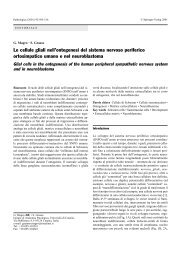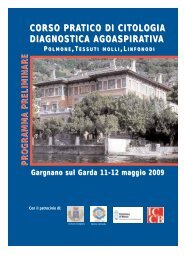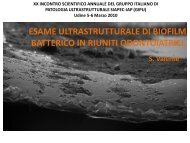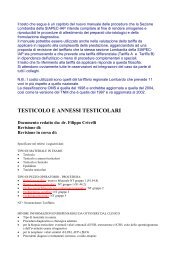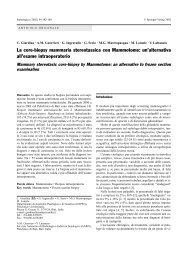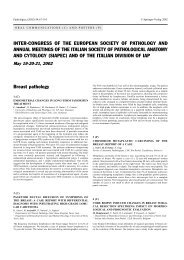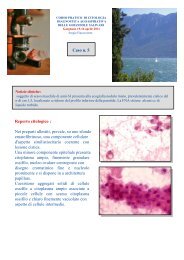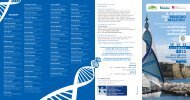Create successful ePaper yourself
Turn your PDF publications into a flip-book with our unique Google optimized e-Paper software.
PATOLOGIA DELLA MAMMELLA353technique targeting the gene amplification, while Immunohistochemistrydetects the protein expression. Usually bothare applied to paraffin embedded tissue. We studied HER-2by FISH and Immunohistochemistry in 86 breast carcinomas,subdivided by histological criteria.MethodsBoth FISH and immunohistochemistry were performed onformalin-fixed, paraffin-embedded samples. FISH was appliedusing the PathVysion Vysis kit labelling HER-2/neugene and chromosome 17 centromere. The immunostainingtechnique was DAKO HercepTest (HT) targeting HER-2 protein.ResultsThe results showed a good overall concordance betweenFISH and HT. In all cases with HercepTest score 0 and 1+ thenon-amplification of gene was observed. The gene amplificationwas found in 17.85% of cases with 2+ score and in72.41% of 3+ cases. Furthermore, we investigated the twovariablescorrelation between chromosome 17 copy number,protein overexpression, gene amplification and presence ofmetastatic lymph nodes.ConclusionsData described in literature for 3+ carcinomas show a 3-10%discrepancy between protein expression and gene amplification,while in this study this difference is up to 20%. As aconsequence, even if usually it is considered important toanalyse by FISH only 2+ cases, 3+ cases may represent a newinteresting subset. The reason why some tumors are FISHpositive and HT negative is still not clear. Other interestingresults were the correlation between HT and chromosome 17aneusomy (aneusomy raises progressively from 0 to 3+score) and between gene amplification and lymph node status(weak inverse correlation, lymph node negatives moreamplified than positives). In conclusion, the FISH techniquecan represent an important and useful diagnostic tool to integratethe result of HT and to select patients for the immunotherapy.Utilizzo di metodologie standardizzate nellavalutazione del gene HER2: risultati sucasistica di 33 carcinomi duttali infiltrantidella mammellaA. Bernardi * , G. Canavese * , G. Candelaresi * , R. Giani ** ,P. Lovadina * , E. Margaria * , E. Berardengo **S.C. Anatomia Patologica; ** S.S.C. Chirurgia Senologica,Polo Oncologico Torino Est, Ospedale S. Giovanni A.S.IntroduzioneNei tumori solidi la prima applicazione di “target terapia” siè ottenuta nel carcinoma mammario con Herceptin, terapiaanti HER2 approvata per il trattamento del sottogruppo dicarcinomi mammari metastatici con overespressione diHER2. Se un marcatore assume valore prognostico predittivodi risposta a terapia la sua valutazione esige standardizzazionedi metodologie operative, di metodica, di lettura dei preparatie valutazione dei dati ottenuti 2 .Metodi13 carcinomi duttali infiltranti della mammella positivi 3+ e20 positivi 2+ al Dako Herceptest sono stati indagati con testdi ibridazione in situ in fluorescenza (Fish) usando DakoHER2 Fish pharmDxTM Kit (con validazione FDA e IVDeuropea) che utilizza un mix di sonde DNA cosmidico controil gene her2 e, con tecnologia PNA, contro il DNA alfa-satellitecentromerico del cromosoma 17 (Cen17) marcate rispettivamentecon Texas Red e Fitc. Da campi differenti in 60nuclei tumorali 1 di ogni caso sono stati contati i segnali fluorescentirossi e verdi al microscopio a fluorescenza con messaa fuoco manuale, obiettivo 100x in immersione e poi analizzaticon software DakoCytomation her2-fish che permette:analisi di immagine multifocale, incremento della risoluzionedel segnale, mantenimento della specificità e sensibilità,definizione manuale dei nuclei, conteggio dei segnali e assemblaggiodei risultati in una tabella riassuntiva dei nucleianalizzati, numero dei segnali Cen 17, numero dei segnaliHer2, rapporto Cen17/Her2, ratio finale.Risultati25/33 carcinomi risultavano her2 amplificati con correlazionestatisticamente significativa (P = 0,03) con alta proliferazione.Un terzo dei casi Fish negativi avevano marcata polisomia.ConclusioniNel sottogruppo di carcinomi mammari infiltranti con overespressionedi Her2 l’applicazione di metodica Fish con kitstandardizzato, supportato da software di analisi d’immagineavanzato: aiuta la corretta valutazione dello stato di her2, discriminadai negativi i tumori positivi per amplificazioneeleggibili a terapia con Herceptin ed evidenzia quei casi nonamplificati in cui il fenomeno di polisomia determina overespressioneproteica.Bibliografia1Persons DL. Ann Clin Lab Science 2000;30:41-48.2Rhodes A. Am J Clin Path 2001;115:44-58.ER negative, p53 positive, breast cancersfrequently express basal and myoepithelialcell markersS. Casnedi, E. Dainese, C. Riva, C. Capella, F. SessaDepartment of Pathology, University of Insubria, VareseIntroductionLuminal, basal and myoepithelial cell differentiation havebeen reported in ductal breast cancer (BC), using severalmarkers, including cytokeratins (CK) 5, CK14, CK8, CK18,actin, S100, CD10 and vimentin. Luminal type BC are frequentlyassociated with ER and PgR positivity and good prognosis.No relationship has been documented about p53 positivity,tumour grade and the expression of basal and myoepithelialmarkers. The aim of our study was to investigate theexpression of CK5 and CK14 in high-grade p53+, ER-BCs,and to correlate it with the expression of myoepithelialmarkers (actin, vimentin and S100).Material and methodsFormalin-fixed, paraffin-embedded sections from 30 selectedBC, p53+, ER-, PgR-, c-erb-B2-negative BCs were immunostainedfor CK14 (clone LL002, 1:20, Novocastra), CK5 (cloneXM26, 1:200, Novocastra), CD10 (clone 56C6, 1:25, Novocastra),S100 (rabbit policlonal antibody, 1:1000, Dako), vimentin(clone V9, 1:30, Dako). A tumour was considered positivewhen 10% or more of tumoral cells were positively stained.ResultsAll cases were G3, ER-, PgR-, c-erb-B2-negative, p53-positiveBCs. The mean age was 64 years ranging from 37 to 90.Fifteen out thirty cases (50%) had lymph node metastases (11N1 and 4 N2). Morphologically these tumours were characterizedby the presence of large sheets of cells sometimes





